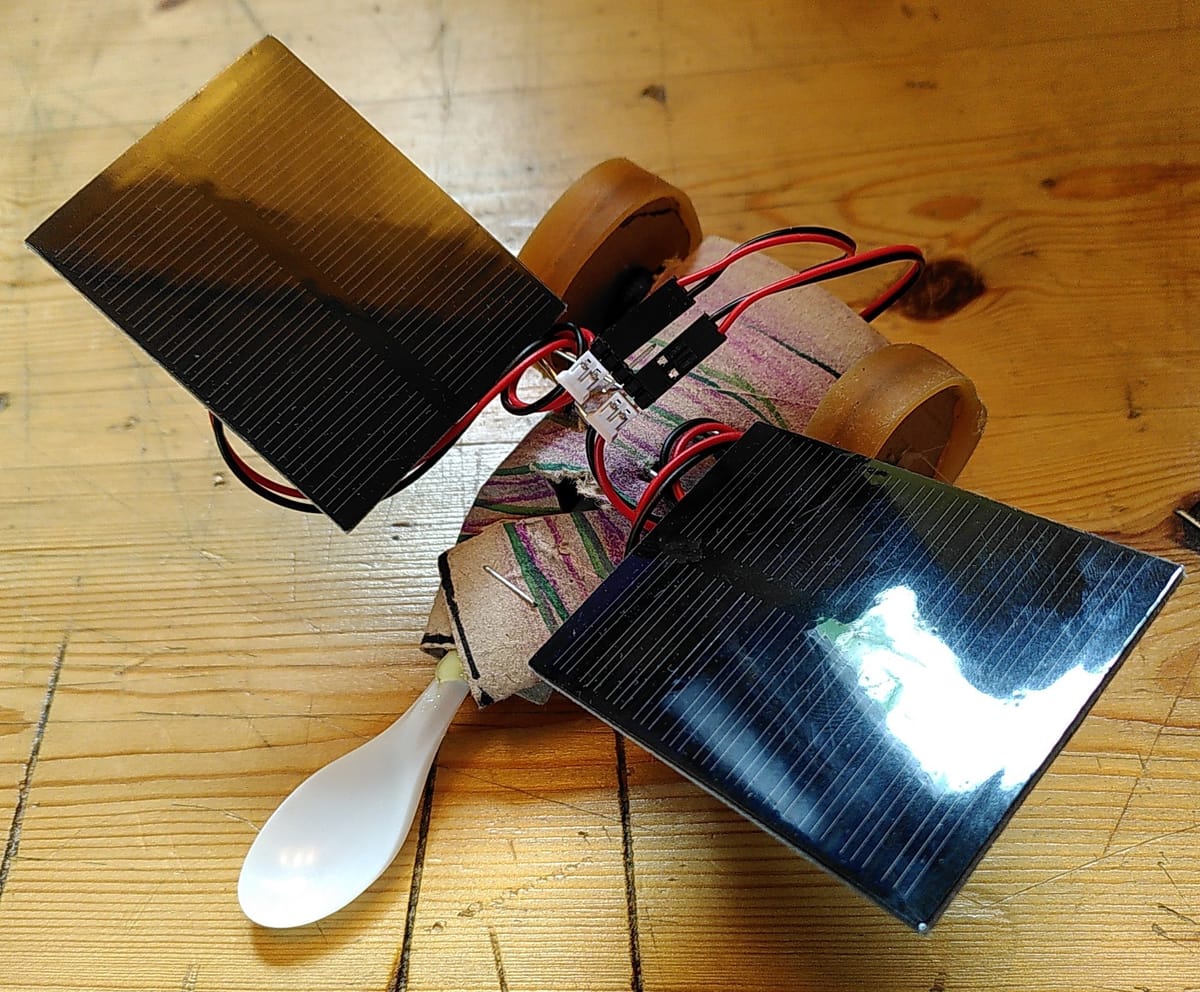Playing with the Sun: Creative learning and energy

This is part 1 of 2 of the essay that kicked off the Playing with the Sun Project. It describes the motivation and thinking behind engaging kids in creative learning experiences involving sustainable energy. Part 2 describes the role of toys in learning through play experiences.
An alien anthropologist visiting earth today could see humanity's relationship to fossil fuels in the toys our children play with. As a little boy drives his toy truck around and fills it up at his pretend gas station, he re-enacts the world as it is today. For the child, toys are "objects to think with," tools that enable them to explore and to understand the complex relationships between the many different things in their world.
What if we made toys that enabled children to research, imagine, and perhaps even invent new relationships to energy through play?
Today there are very few toys that let children play with the generation and use of energy in a way that's open-ended. Fewer still invite them to propose new ideas and ask questions that adults don't already know the answers to. And yet most adults today don't seem to have a sophisticated or intuitive understanding of how energy is cultivated, or how it might be put to use more creatively and sustainably. Imagine, for a moment, that this isn't because they weren't taught enough about sustainability in school. Most adults have forgotten much of what they learned in school anyway. What if their lack of an intuitive understanding about energy is due to the inadequacy of their toys, their "tools to think with"?
If humanity is to learn to live sustainably in time to prevent catastrophic climate change, perhaps part of our strategy could be to create toys and play materials that enable us to explore new relationships with energy. For example, we know that with sustainable energy like wind and solar, the time between the generation of energy and the spending of it is usually measured in minutes and hours, and not millions of years, as with fossil fuels. Could toys help children and adults explore ways of using energy closer to its source in both space and time?
As we imagine different relationships to energy in which toys play a role, we can look to our history for inspiration. Until a few centuries ago, most goods were moved by sail. What is the relationship of the sailor to the wind? It might begin with the sailor as a child playing with a toy sailboat, exploring its different relationships to the breeze, and perhaps blowing on the sail. As it grows to maturity, the relationship becomes one of careful attention, of respect and deference to nature. There is a love for efficiency and elegance integrated so deeply with sailing that it is often described aesthetically.
How can we create the conditions for play as a means to develop an intuitive understanding of energy, similar to the child learning to sail by playing with a boat? What sort of toys can we create that might enable children to develop a relationship with the sun that's closer to the relationship of the sailor to the wind?
Bateson's Interlocked Horse and Grass
Gregory Bateson, an anthropologist credited with co-founding the disciplines of cybernetics and family therapy, spent a great deal of time thinking and writing about relationships. In this 1 minute long video clip from his daughter Nora Bateson's documentary film titled An Ecology of Mind, Bateson describes the relationship between the horse and the grassy plain.
<1 minute clip from An Ecology of Mind: A Daughter's Portrait of Gregory Bateson, Bullfrog Films. (2011)
The relationship between horses and grass that has evolved over millennia has them "interlocked" to such a degree that it doesn't make sense to think of them in isolation. The fact that we do tend to think of horses without thinking about grass is perhaps more an artifact of our linguistic style of thinking than a true representation of the actual state of affairs. Is a horse really distinct from his environment? Perhaps in shorter timescales, but probably not in longer ones.
You could of course take a horse out of the field and put it in an empty white room and feed it synthetic grass pellets. But that would require a lot of work simulating the horse's natural environment, the grassy fields. As Bateson describes in the video, removing the horse from the relationship with the grass means that humans who want lawns have to take on the roles the horse normally handles. One must replace the horse's teeth with a lawnmower 1, and his digestive system with fertilizer. Otherwise the grass won't last more than a few years, because without the horse to keep it clear the open field will soon be replaced by bushes and trees.
Just as the horse co-evolved with grass over generations, each interlocked in a collaborative mutually beneficial relationship with the other, so has our relationship to energy co-evolved over the past few centuries with fossil fuels. If we want to change that relationship on the scale of years and generations, we need to consider how human beings first encounter and understand their relationship to energy in light of Bateson's observations about horses and grass.
The Infinite River
Today when we need energy for something in our homes, we simply plug it in. This connects our device to a vast network of energy transmission and production, still mostly driven by fossil fuels. For the end user it is nothing if not consistent: Our device is given the same kind of power regardless of how sunny it is, or how hard the wind is blowing. The child (at least the privileged child, likely to inherit power and privilege) learns that whenever you want power, you simply plug-in to the infinite river. There is no need to consider whether the sun is or isn't shining today, because the power comes from sunny days some 200 million years ago.
The structure and norms of our power grid evolved out of our interlocked relationship with fossil fuels. There are absolutely no situations in nature in which an organism can take as much energy as it wants from sunlight stored 200 million years ago whenever it wants it and pay the bill in a month. A tree cannot plug-in to a perfectly consistent power grid. It has to grow and store energy while the sun shines, and carefully husband what it has saved for when the sun isn't shining. Its energy use is tightly coupled with its energy cultivation. Like all living things, much of its evolutionary creativity has developed within the constraint of its relationship to energy.
If we want to create the possibility for change in the relationship between people and energy, we need to enable both sides of the interlocked relationship - the horse and the grass - to explore different possibilities, and find new ways to relate. In this metaphor, people are horses and the designed objects that use and produce energy in the built environment are the grass. This will be a co-design process lasting generations, so it is important to look at how human beings first begin to understand relationships between the things in their world.
Part 2 of this essay is focuses on the role of toys and play materials in learning through play experiences.
